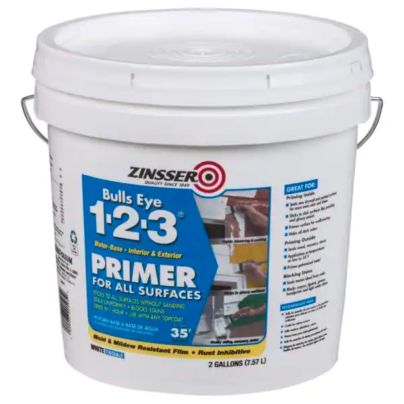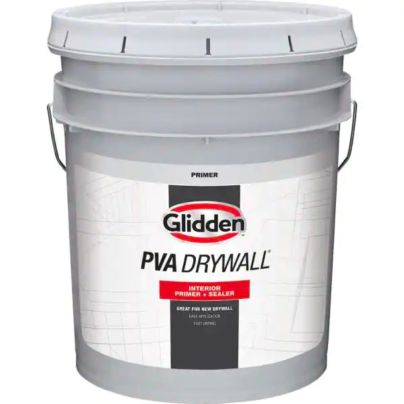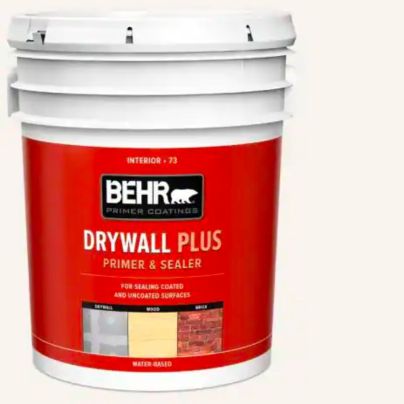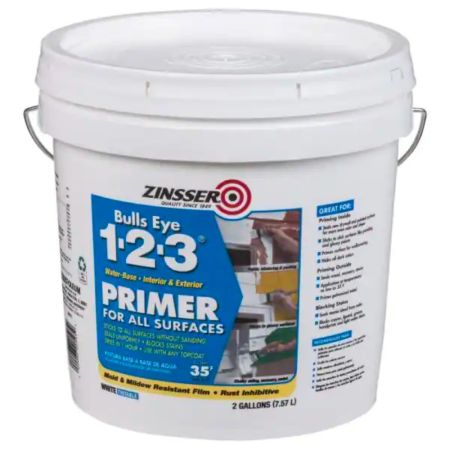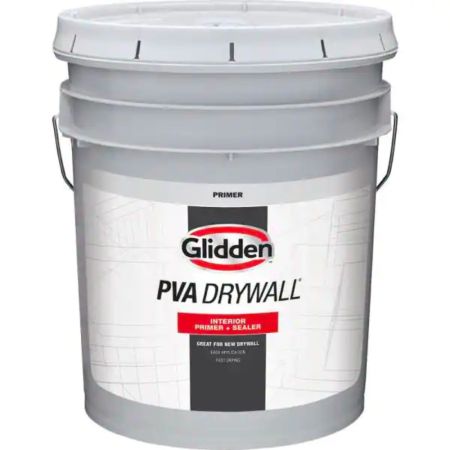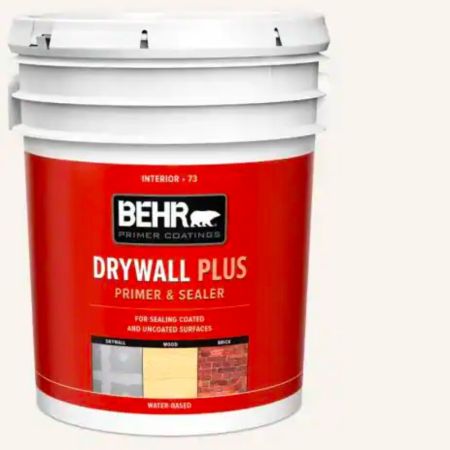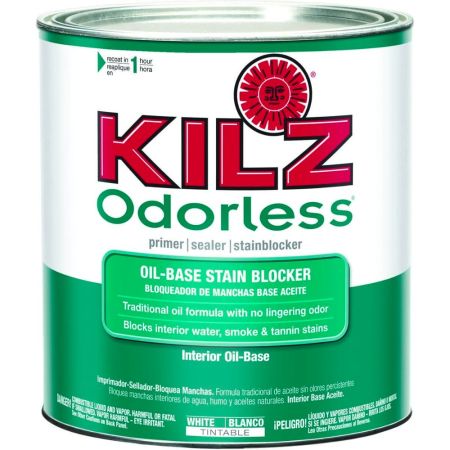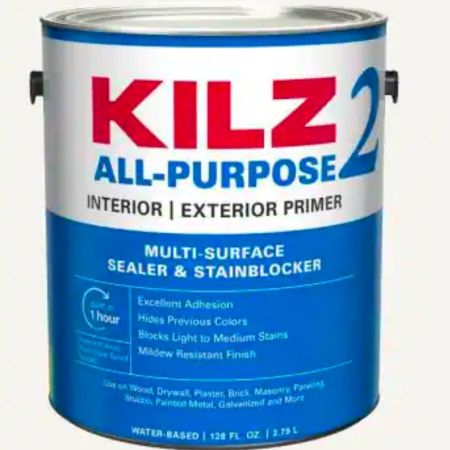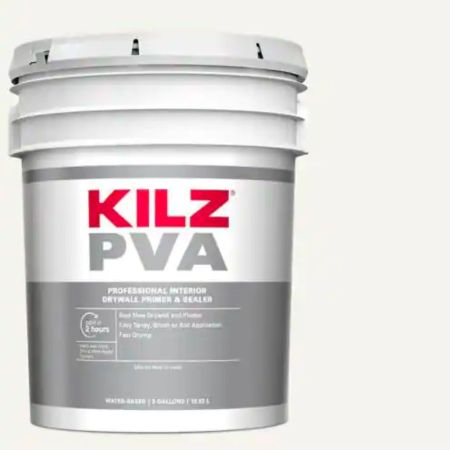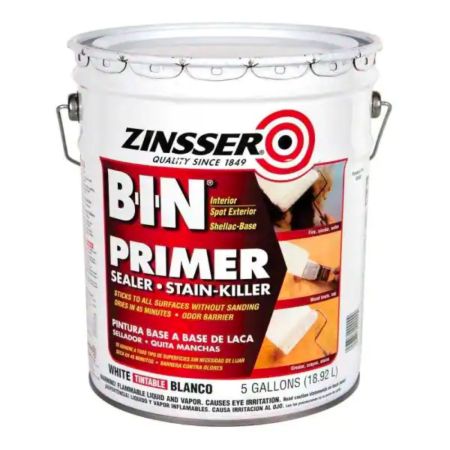We may earn revenue from the products available on this page and participate in affiliate programs. Learn More ›
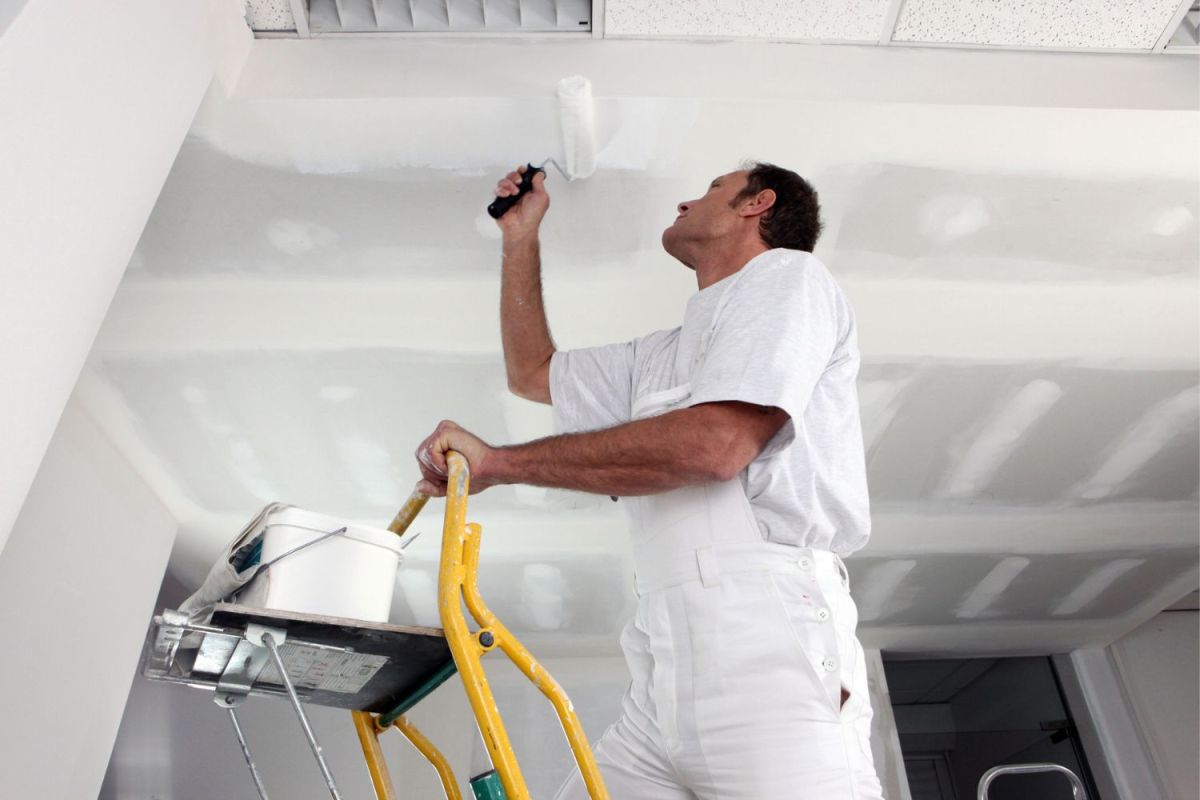
Fresh drywall is very dry and can soak up expensive paint like a sponge. It can also make it difficult to drag a paint brush or roller across the surface for pro-level painting. However, drywall primers can seal those pores and allow tools to glide across the surface, resulting in a better-looking finished product.
Just as it’s important to prime fresh drywall, it’s also crucial to purchase high-quality primer that will seal and fill small holes and pores, creating a uniform surface for paint. But how would a shopper know what to look for in the best drywall primer? Keep reading to find out.
- BEST OVERALL: Zinsser Bulls Eye 1-2-3 Water-Based Primer and Sealer
- BEST BANG FOR THE BUCK: Glidden PVA 5 gal. Drywall Interior Primer
- UPGRADE PICK: Behr Acrylic Interior Drywall Plus Primer and Sealer
- BEST OIL-BASED: Kilz Odorless Primer/Sealer, Oil Based
- BEST WATER-BASED: Kilz 2 All Purpose Interior/Exterior Primer, Sealer
- BEST PVA PRIMER: Kilz PVA 5 Gal. White Interior Drywall Primer
- BEST SHELLAC: Zinsser B-I-N Shellac-Based Interior Primer & Sealer
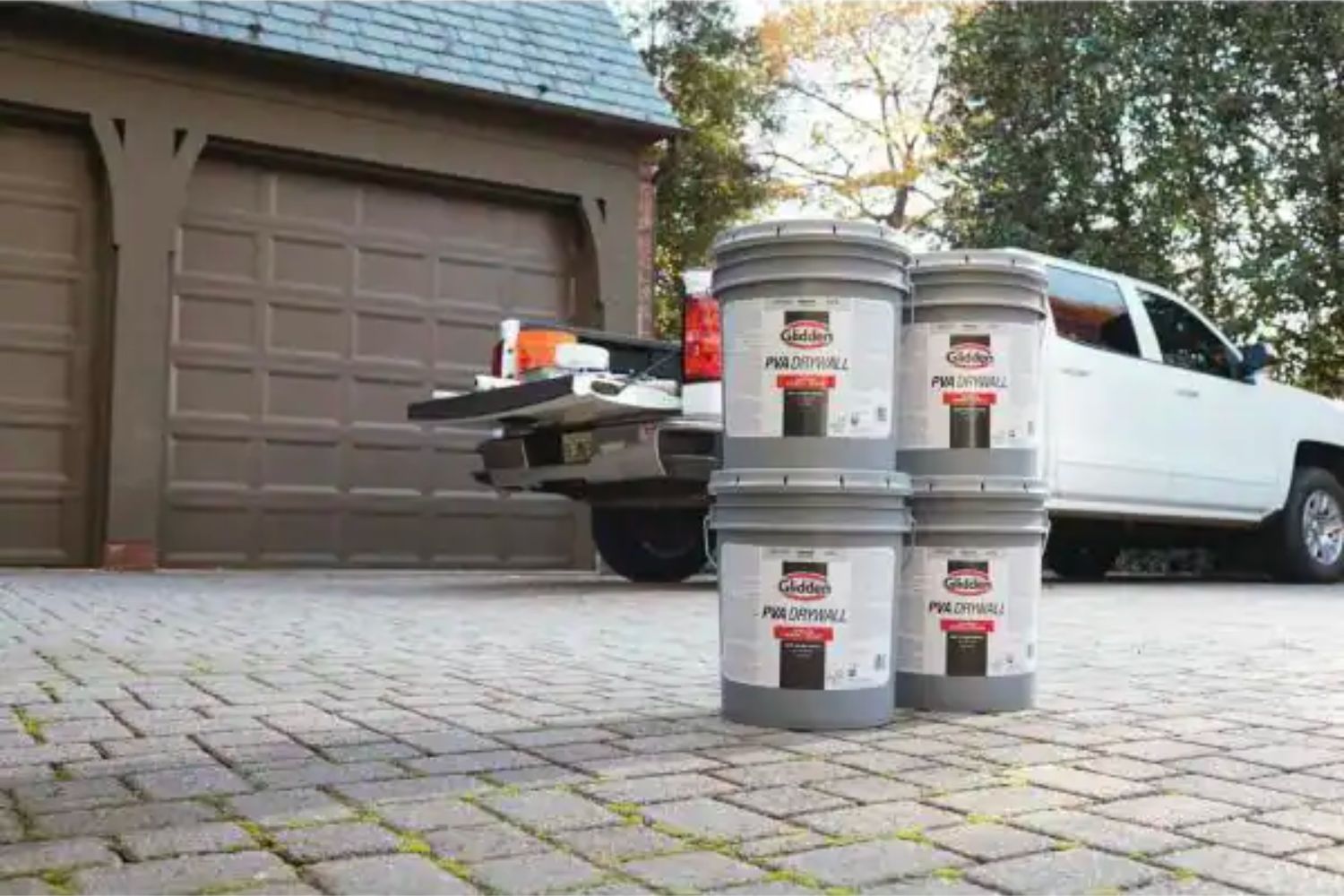
Types of Primer for Drywall
Primer is primer is primer, right? Not exactly. There are lots of different types of primers, and they’re not all ideal for any job. The following sections include primers that a DIYer could use, with some tips on when they should (or shouldn’t) use certain types.
Oil-Based
Oil-based primers are excellent for covering stains and sealing wood, but they’re not always ideal for drywall. They will seal the surface, but oil-based primers contain high levels of VOCs (volatile organic compounds) and they don’t accept latex paint well. However, they’re a good choice for priming drywall before wallpaper or paneling.
Water-Based and Latex
The terms “water-based” and “latex” describe the same primers. Most drywall primers are water-based products, and there are a lot of benefits to these primers. First, they’re low-VOC, so breathing around them is safer than oil-based primers. Also, they’re inexpensive and spread easily. They seal fresh drywall well, and they’re a great base for latex paints.
Polyvinyl Acetate (PVA)
Polyvinyl acetate (PVA) primer is the best primer for new drywall. This primer seals the pores of drywall surfaces quickly and easily, and it’s also highly sandable, so it is simple to fine-tune the surface with a sanding block or stick after a primer coat. Since PVA primer is water-based, it’s an ideal base coat for latex paints; it also emits low levels of VOCs.
Shellac
For stained drywall, there’s always a shellac-based primer. These primers cover stains well, dry relatively quickly, and leave behind a tacky surface that grabs paint. Shellac primer serves as a solid base for oil and latex paints, but these primers often contain high levels of VOC compared to latex or PVA primers.
What to Consider When Choosing the Best Drywall Primer
Knowing the different types of primer is a good start, but choosing the best drywall primer requires a bit more background. Below are some of the most important considerations to keep in mind when comparing drywall primers. Some shopping considerations will apply more to certain types of primers than to others.
Drying Time
Drywall is a very dry, porous surface and can quickly soak up any coating applied, resulting in faster drying times. However, some drywall primers—or just primers in general—dry at different rates, which could be a factor when shopping. Water-based primers dry relatively quickly, while oil-based primers take much longer.
If the project needs to go from drywall to finish coat in a weekend, go with a fast-drying primer. A good rule is to look for a drywall primer that states that it’s top-coat-ready in 1 hour. This time frame will allow the painter time to coat the room with primer and switch almost immediately to painting, maintaining a speedy workflow.
VOCs and Odor
Paints and primers contain volatile organic compounds, or VOCs, and they’re emitted through noxious gases. These gases contain chemicals that have varying short-term and long-term effects on a person’s health.
Oil-based and shellac primers are typically heavily laden with VOCs, which makes it dangerous to work with them in small rooms with poor ventilation. Should DIYers choose one of these primers, they should open windows and use fans to circulate the air out of the room. They should also wear a respirator mask.
For those who would prefer a potentially less dangerous priming experience, go with latex or water-based primers. These primers contain some VOCs, but at much lower concentrations. Those who are particularly sensitive might still prefer to wear a respirator and open a window.
Moisture and Stain Resistance
In some environments—such as in a bathroom or another damp space—a DIYer might need to protect the drywall by sealing against moisture. When this is the case, shellac and oil-based primers are often the most effective, though some latex primers are suitable for damp applications. Just be sure to check the manufacturer’s label.
Much of the same information applies to hiding stains. Shellac is excellent at hiding existing stains on drywall, and oil-based primers also are suitable for hiding stains. However, certain water-based primers are also up for the task, though basic PVA primers are not. Check the manufacturer’s label to ensure that a specific primer has stain-hiding properties.
Our Top Picks
Even with all that background on the best primer for drywall, shopping might seem a bit overwhelming. The following list of products should help, since there’s a choice for nearly every situation. Just be sure to keep the top considerations in mind when comparing these products.
Best Overall
Zinsser Bulls Eye 1-2-3 Water-Based Primer and Sealer
See ItSome DIYers prefer one primer that can do it all—from drywall to concrete and wood—and Zinsser Bulls Eye 1-2-3 can cover all the bases. This water-based primer is available in several sizes, but a 2-gallon bucket can cover up to 800 square feet, preparing the surface for final coats of latex or oil-based paints and wall coverings.
This primer will seal and prepare fresh drywall for paint, plus it can protect against mold and mildew. It can cover stains, graffiti, wood tannins, and other discolorations as well. It has a 35-minute dry time and will dry in temperatures as low as 35 degrees. This primer might be a bit thick for a paint sprayer, but since it’s water-based, thinning it out a bit isn’t a problem.
Product Specs
- Type: Water-based
- Dry time: 35 minutes
- Low-VOC: Yes
Pros
- Covers stains, paint, tannins, and other discolorations
- Dries in just 35 minutes
- Protects against mold and mildew
Cons
- Might be too thick for a paint sprayer
Get the Zinsser Bulls Eye drywall primer at The Home Depot or Lowe’s.
Best Bang For The Buck
Glidden PVA 5 gal. Drywall Interior Primer
See ItFor DIYers on a budget, check out Glidden’s PVA Drywall Interior Primer. This 5-gallon bucket of PVA primer offers enough coverage for up to 45 sheets of drywall at an affordable price. This primer is water-based and features a low-VOC formula, putting those with health concerns at ease while priming their drywall projects.
This primer and sealer combo will seal pores of new drywall and cover existing paint, which is especially suitable for renovation projects where old walls meet new. It will also seal out moisture from affecting the drywall surface. Although the product says it is a quick-dry formula, it won’t be ready for a top coat for at least 2 hours, so plan ahead.
Product Specs
- Type: PVA
- Dry time: 2 hours
- Low-VOC: Yes
Pros
- Seals new drywall and covers old paint
- Affordable price point
- Covers up to 45 sheets of drywall
Cons
- 2-hour dry time
Get the Glidden interior drywall primer at The Home Depot orWalmart.
Upgrade Pick
Behr Acrylic Interior Drywall Plus Primer and Sealer
See ItFor a premium drywall priming and sealing solution, check out Behr’s Drywall Plus primer and sealer. This water-based sealer features a low-VOC formula that will cover drywall, brick, wood, metal, and glossy surfaces. It blocks stains and seals porous surfaces, allowing paint to go further and result in a better finish.
Behr’s 5-gallon bucket of Drywall Plus primer and sealer will cover between 1,250 and 2,000 square feet. With that coverage and its usefulness covering additional surfaces other than drywall, it’s a good choice for renovations and new construction. Also, its 30-minute dry time will keep the work moving along. If there’s a downside, it’s a little expensive.
Product Specs
- Type: Water-based
- Dry time: 30 minutes
- Low-VOC: Yes
Pros
- Mildew-resistant
- Works on multiple surfaces
- 30-minute dry time
Cons
- A little expensive
Get the Behr Drywall Plus primer at The Home Depot or Walmart.
Best Oil-Based
Kilz Odorless Primer/Sealer, Oil Based
See ItWhen a drywall job calls for a tough oil-based primer, be sure to consider Kilz Odorless Primer and Sealer. This primer and sealer works on brick, metal, glossy surfaces, drywall, paneling, wallpaper, masonry, plaster, and wood. Each 1-gallon can has the potential to cover up to 400 square feet.
It’s important to understand one thing: While this primer states that it’s odorless, it is not low-VOC. It will require plenty of ventilation and a respirator to apply safely. However, this product will dry to an odorless finish, and it will block stains, tannins, and other discolorations or marks. It will dry to the touch in 30 minutes and it’s ready for a recoat in 1 hour.
Product Specs
- Type: Oil-based
- Dry time: 30 minutes
- Low-VOC: No
Pros
- Blocks stains, tannins, and other discoloration
- Dries to an odorless finish
- Works on a variety of surfaces
Cons
- Absolutely not low-VOC
Get the Kilz oil-based primer and sealer on Amazon.
Best Water-Based
Kilz 2 All Purpose Interior/Exterior Primer, Sealer
See ItDIYers who prefer the easy cleanup and more environmentally friendly approach to water-based priming should check out Kilz 2 All Purpose Primer and Sealer. It features a low-VOC formula that’s capable of covering drywall, wood, plaster, stucco, paneling, masonry, and a variety of other materials, both indoors and out.
One gallon of primer can cover up to 400 square feet of material, and it’s ready for a top coat in 1 hour. The finished primer coat is mildew-resistant and will block light-to-medium stains and prevent them from showing through finish coats, but it won’t handle heavier stains.
Product Specs
- Type: Water-based
- Dry time: 1 hour
- Low-VOC: Yes
Pros
- Mildew-resistant
- Works on a variety of surfaces
- Seals pores and promotes adhesion
Cons
- Will not cover heavy stains
Get the Kilz 2 water-based primer and sealer at Ace Hardware or The Home Depot.
Best PVA Primer
Kilz PVA 5 Gal. White Interior Drywall Primer
See ItWhen it comes to quickly sealing off the pores of fresh drywall and blending mud in with raw paper, nothing beats the simplicity of a PVA primer. This low-VOC PVA primer from Kilz is a prime example. One 5-gallon bucket can cover up to 2,000 square feet of drywall.
This PVA primer is thin enough to roll, brush, or spray, allowing DIYers to coat their surfaces quickly and easily. While it does dry quickly, it requires 24 hours of setting time before applying a top coat. That is a lot of downtime, but it will save time on additional coats of paint in the future.
Product Specs
- Type: PVA, water-based
- Dry time: 24 hours total
- Low-VOC: Yes
Pros
- Brush, rolls, or sprays on
- 5 gallons covers up to 2,000 square feet of porous drywall
- Low-VOC formula
Cons
- Takes 24 hours to dry before top coat
Get the Kilz PVA primer at The Home Depot.
Best Shellac
Zinsser B-I-N Shellac-Based Interior Primer u0026 Sealer
See ItFor drywall and other surfaces with heavy stains, Zinsser’s B-I-N shellac-based interior primer and sealer is up to the task. This primer dries fast and hides pet, smoke, and tobacco stains. It also promotes adhesion with the top coat, ensuring the finished product looks great.
This shellac-based primer and sealer will adhere to many surfaces, including drywall, wood, masonry, brick, and even glossy surfaces. It dries in just 20 minutes as well. Do keep in mind that as a shellac-based primer, it is not low-VOC, so remember to open a window and wear a respirator mask.
Product Specs
- Type: Shellac-based
- Dry time: 20 minutes
- Low-VOC: No
Pros
- Dries in just 20 minutes
- Covers a variety of surfaces
- Hides tough stains and promotes paint adhesion
Cons
- Not low-VOC
Get the Zinsser shellac-based primer at Ace Hardware or The Home Depot.
Our Verdict
For DIYers who are just looking for an all-purpose primer that can handle drywall as well as wood, masonry, and other porous surfaces, give Zinsser Bulls Eye 1-2-3 a try. Those who want a pure-PVA drywall primer might check out Kilz PVA and should enjoy its easy application and cleanup.
How We Chose the Best Drywall Primers
Putting together a list of the best drywall primers was no small task. After all, not all primers are equal in quality or capability, so it’s important not to paint them all with a broad brush.
First, we relied on our own experience with painting projects to consider the things we look for and look out for when choosing primers. Next, we performed extensive product research on drywall primers that met those needs and compared their coverage, dry time, and price. Anything we felt didn’t offer enough value, we tossed aside.
Finally, we took a look at the remaining drywall primers and assessed them for their strengths and weaknesses. By that point, we had a list of the best drywall primers.
Tips for Using Drywall Primers
The following priming tips will help with most drywall projects.
For best results, sweep the drywall surface with a brush to remove any sanding dust that might lay on the surface. While the primer can blend this dust in, the primer won’t flow as far, and some areas can appear thicker than others.
If the weather is humid, primer will take longer to dry. Promote fast drying by turning on a ceiling fan or positioning a box fan in the room to circulate the air.
It’s not necessary to be overly exact while priming, but it does help to cut in along the ceilings and corners. With about 6 inches of painted surface to overlap, the roller won’t bump into the ceiling or adjacent wall and create high spots.
- Brush the drywall surface with a broom to remove sanding dust before priming.
- Turn on a ceiling fan or box fan to promote faster drying in humid weather.
- Cut in along the ceilings and corners to prevent high spots.
FAQs
If your head is still spinning with all that information about the best drywall primers, don’t fret. The following sections include some common questions about drywall primers. Be sure to check for an answer to your question listed below.
Q. Do I need to apply drywall primer before painting?
Yes. If you don’t prime first, the drywall will soak up the paint and result in an uneven, dull finish. Priming the drywall first will leave an even finish and allow the painter to stretch a gallon of paint further.
Q. How long does it take for primer to dry?
Shellac-based primers can dry very quickly, often in just 20 minutes or so. Water-based primers might take 30 to 60 minutes, and oil-based primers can take even longer. Be sure to check the stated drying time and ready time to top coat on the product instructions.
Q. How many coats of drywall primer do I need?
In most cases, one coat of drywall primer is all that is necessary. However, how many coats are actually necessary depends on the condition of the drywall, especially if there are stains and other discolorations.
Q. Can I tint drywall primer?
Most water-based drywall primers are tintable, but it depends on the specific product.
Q. Are there any differences between drywall primer and paint primer?
Drywall primer is specially designed for drywall. It contains the same chemicals as a typical white glue, and it seals the pores without a heavy coat. Paint primer can also seal the pores, but it’s often thicker and more expensive.
Q. Can I use drywall primer on wood?
Standard primers are a better choice for wood. They’ll adhere better and promote a better finish in the long run than a standard PVA primer.
